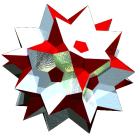|
Acronym
|
...
|
|
Name
|
Double Hessian polyhedron,
complex polyhedron x2-4-o3-3-o3
|
|
Circumradius
|
1
|
|
Vertex figure
|
x3-4-o2
|
|
Coordinates
|
-
(ε3n, ε3m, ε3k)/sqrt(3) & for any 1≤n,m,k≤3
-
(-ε3n, -ε3m, -ε3k)/sqrt(3) & for any 1≤n,m,k≤3
where: ε3=exp(2πi/3)=(-1+i sqrt(3))/2
|
|
Dual
|
x3-3-o3-4-o2
|
|
Face vector
|
54, 216, 72
|
|
Confer
|
- real space embedding:
-
o3o3o3o3o *c3m
- general polytopal classes:
-
complex polytopes
|
External
links
|


|
This complex polyhedron not only is the formal dual of the complex polytope
x3-3-o3-4-o2,
but also its real space embedding is the dual of that there given one, i.e. it is o3o3o3o3o *c3m.
As the edges in this complex polyhedron are 2-fold and thence just real ones, these edges are to be searched as a subset of the
real polypeton's edges.
The complex faces however are full dimensional and already are described to be embedded in triddits,
which in turn are the polychoral elements of that real polypeton, a subset of which here then is to be chosen.
By application of duality, the incidence matrix thence is simply the same as of its dual
x3-3-o3-4-o2, just rotated 180° around.
Since s2-4-o3-3-o3 comes out to be nothing but
x3-3-o3-3-o3, it furthermore becomes evident that the vertex set
of the complex polyhedron in here is nothing but two mutually inverted copies of the vertices of that one
(within conformance that its real space embedding likewise is known to be the tegum sum of
2 inverted jaks). In fact, the 2-edges in here
simply connect any vertex of the one to one out of the 8 nearest vertices of the other.
Within the above provided metrics accordingly these in here re-used lacing edges are assumed to have unit lengths.
Incidence matrix according to Dynkin symbol
x2-4-o3-3-o3
. . . | 54 ♦ 8 | 8
-------------+----+-----+---
x2 . . | 2 | 216 | 3
-------------+----+-----+---
x2-4-o3 . ♦ 6 | 9 | 72
snubbed forms: s2-4-o3-3-o3

